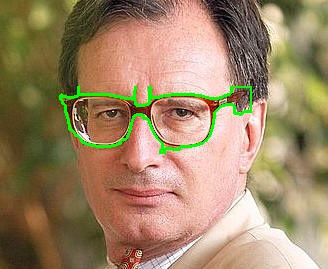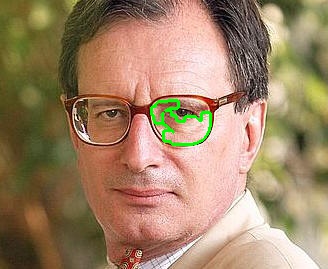I am using OpenCV+Python to detect and extract eyeglasses from a (face) image. My line of reasoning is the following:
1) Detect the face
2) Find the largest contour in the face area which must be the outer frame of the glasses
3) Find the second and third largest contours in the face area which must be the frame of the two lenses
4) Extract the area between these contours which essentially represents the eyeglasses
However, findContours() does find the outer frame of the glasses as contour but it does not accurately find the frame of the two lenses as contours.
My results are the following:


What can I do to fix this?
import cv2
import numpy as np
import matplotlib.pyplot as plt
img = cv2.imread('Luc_Marion.jpg')
RGB_img = cv2.cvtColor(img, cv2.COLOR_BGR2RGB)
gray_img = cv2.cvtColor(img, cv2.COLOR_BGR2GRAY)
# Detect the face in the image
haar_face_cascade = cv2.CascadeClassifier('haarcascade_frontalface_default.xml')
faces = haar_face_cascade.detectMultiScale(gray_img, scaleFactor=1.1, minNeighbors=8);
# Loop in all detected faces - in our case it is only one
for (x,y,w,h) in faces:
cv2.rectangle(RGB_img,(x,y),(x+w,y+h),(255,0,0), 1)
# Focus on the face as a region of interest
roi = img[int(y+h/4):int(y+2.3*h/4), x:x+w]
roi_gray = gray_img[int(y+h/4):int(y+2.3*h/4), x:x+w]
# Apply smoothing to roi
roi_blur = cv2.GaussianBlur(roi_gray, (5, 5), 0)
# Use Canny to detect edges
edges = cv2.Canny(roi_gray, 250, 300, 3)
# Dilate and erode to thicken the edges
kernel = np.ones((3, 3), np.uint8)
edg_dil = cv2.dilate(edges, kernel, iterations = 3)
edg_er = cv2.erode(edg_dil, kernel, iterations = 3)
# Thresholding instead of Canny does not really make things better
# ret, thresh = cv2.threshold(roi_blur, 127, 255, cv2.THRESH_BINARY+cv2.THRESH_OTSU)
# thresh = cv2.adaptiveThreshold(blur_edg, 255, cv2.ADAPTIVE_THRESH_GAUSSIAN_C, cv2.THRESH_BINARY, 115, 1)
# Find and sort contours by contour area
cont_img, contours, hierarchy = cv2.findContours(edg_er, cv2.RETR_TREE, cv2.CHAIN_APPROX_NONE)
print("Number of contours: ", len(contours))
cont_sort = sorted(contours, key=cv2.contourArea, reverse=True)
# Draw n-th contour on original roi
cv2.drawContours(roi, cont_sort[0], -1, (0, 255, 0), 2)
mask_roi = mask[int(y+h/4):int(y+2.3*h/4), x:x+w]
cv2.drawContours(mask_roi, cont_sort[0], -1, (255,255,255), 2)
plt.imshow(RGB_img)
plt.show()


